For his first exhibition at the Galleria Vismara in Milan in 1965, Luciano Fabro wrote a short text about each of the works displayed. The following words accompanied a sculpture from 1964, titled Tondo e rettangolo (circle and rectangle): ‘The work consists of a circle and a rectangle set side by side and placed on the ground […]. In the reflective circle another circle with axes different from the one with a mirror surface is marked in transparence. In the mirrored rectangle is inscribed a circle identical to the circular piece of glass in which mirroring and transparence are inverted.’
The language is precise, mathematical – tautological even, given the presence of the works in the room alongside the texts. Asked in an interview that same year why he wrote about his art in this way, Fabro explained: ‘Really, I wanted to suggest that viewers should not take up specific or conventional stances, but should simply respond to what they see […]. We must read things, not our own thoughts.’
Fabro’s description of Tondo e rettangolo is reprinted in a catalogue produced by Simon Lee Gallery to coincide with an exhibition of the artist’s early works, all originally produced in the early 1960s and recreated in new editions in the final years before his death in 2007. The works are fashioned from the same small handful of materials and shapes: tubes of stainless steel; circular and rectangular sheets of transparent and reflective glass; thin lines cutting out, carved into, or painted on to hard surfaces. (And, in one anomalous case, a series of pot plants, in which is a long steel tube is horizontally embedded.)
In each sculpture, the sober monochromatic geometry is disturbed by the intrusion of some external or natural force. The organic matter comprising Tuba da mettere tra i fiori (tube to place among flowers) is the most literal, and extreme example. Elsewhere, straight lines of steel bend barely perceptibly under their own weight; in mirrored surfaces, the viewer’s body is glimpsed in moving fragments. The effect of these variations is to draw attention to our experience of the works as material objects existing in time and space – to the thingness of these things. Fabro’s dry, matter-of-fact captions constituted a repetition of this point.
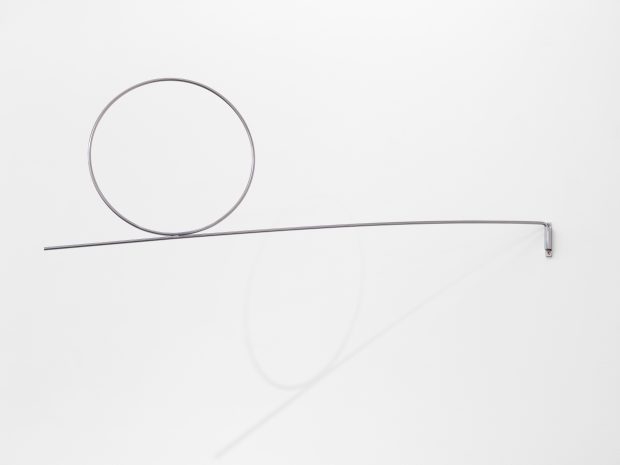
‘Luciano Fabro’. Installation view at Simon Lee Gallery, London, 2017. Photo: Todd White Art Photography; courtesy the Archivio Luciano e Carla Fabro and Simon Lee Gallery
Tautology, far from being the result of laziness or accident, was an aesthetic strategy for Fabro. Two years after the Galleria Vismara show, in an essay titled ‘Arte Povera: Notes for a Guerrilla War’, Germano Celant included Fabro in a group of artists working in and around northern Italy whom Celant perceived as making a new kind of art – not a school, or a style, but an ‘attitude’ – that, in its rejection of grand materials and statements, was both philosophical and indirectly political: ‘a poor art, committed to contingency, to events, to the non-historical, to the present’. In Fabro’s case, it was tautology that Celant identified as a tool for eliminating ‘superstructures’ (ideas, ideologies) and ‘begin[ning] again to have awareness of the present and the world’.
Visitors familiar with the work of the more high-profile poveristi (Jannis Kounellis’s lives horses and burlap sacks filled with dried beans; Mario Merz’s assemblages of household objects, wood, wax, and clay) may be surprised by the lack of obvious ‘poverty’ or, with one obvious exception, living matter in Fabro’s selection of smooth, clean, high-tech materials. But it was precisely this refusal to meet expectations, to be neatly packaged as a marketable brand, that Celant found so exciting and politically significant about Arte Povera – and that soon led to its deliberate downfall when, in 1971, he published another article announcing its ‘failure’. At the root of this decision was a deep-seated ambivalence, shared by artists and critic, over their works’ position in relation to political, social and economic realities: the perhaps inevitable tendency to homogenise a proudly diverse output, and its even more inevitable incorporation into a market context.
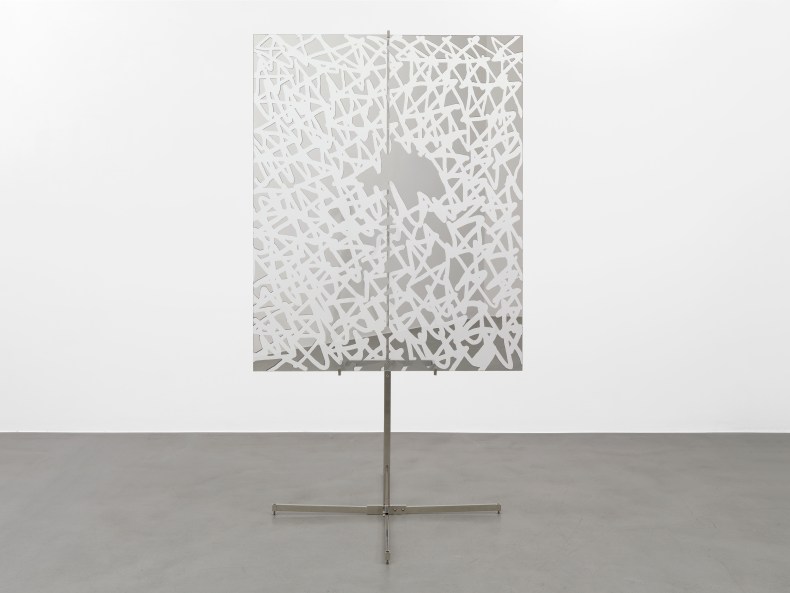
‘Luciano Fabro’. Installation view at Simon Lee Gallery, London, 2017. Photo: Todd White Art Photography; courtesy the Archivio Luciano e Carla Fabro and Simon Lee Gallery
In light of this knowledge, it will always be a strange and somewhat muted experience to encounter Fabro’s sculptures inside a white cube, as we do at Simon Lee. The artist stated that in an ideal world Tuba da mettere tra i fiori would be displayed outdoors; it was ‘intended for a small garden in Milan, but was never placed there’. As a second-best option, he took the work ‘on visits to those friends who had lots of plants in their home or had a garden’. The steel structures, too, take on a delightful and detailed liveliness when situated outside, if an archival photograph of Tondo e rettangolo in a leafy park is anything to go by.
In the gallery, the sculptures create imperfect angles as they play against the corners of the room; cut-out circles are set against a large glass window; steel tubes seem to mirror pre-existing light fittings. It’s a testament to the sensitive placements of the exhibition’s organisers that, despite the space’s restrictions, the works continue to find new ways of existing in and interacting with the world.
‘Luciano Fabro’ is at Simon Lee Gallery, London, until 11 January 2018.
Unlimited access from just $16 every 3 months
Subscribe to get unlimited and exclusive access to the top art stories, interviews and exhibition reviews.

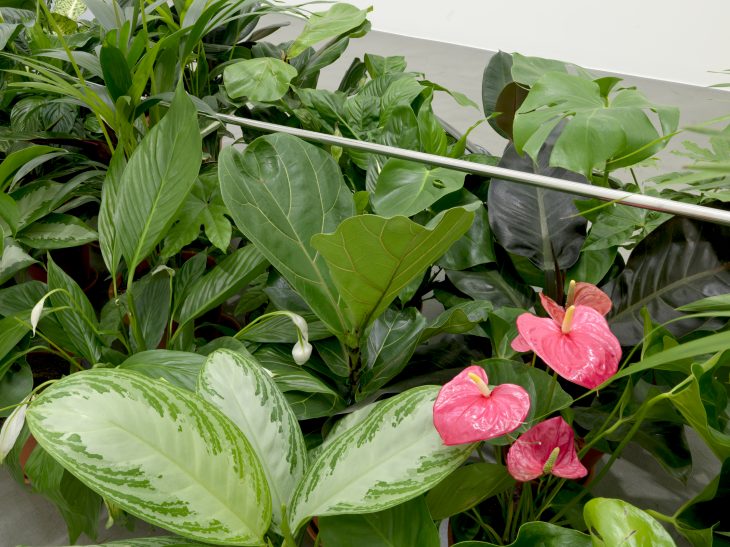

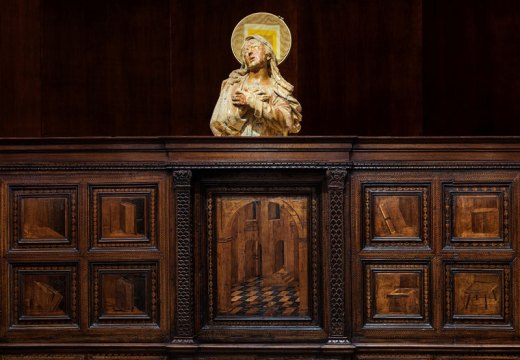
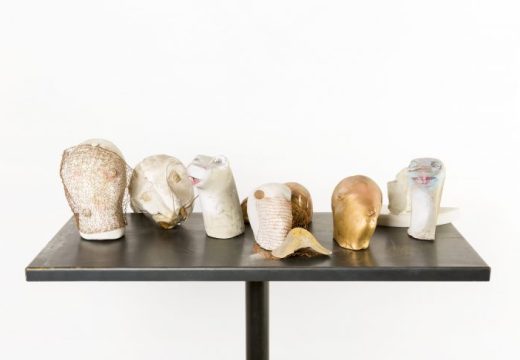









![Masterpiece [Re]discovery 2022. Photo: Ben Fisher Photography, courtesy of Masterpiece London](http://www.apollo-magazine.com/wp-content/uploads/2022/07/MPL2022_4263.jpg)
It’s time for the government of London to return to its rightful home